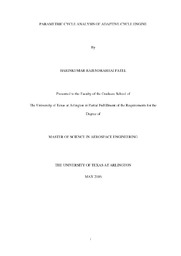
ATTENTION: The works hosted here are being migrated to a new repository that will consolidate resources, improve discoverability, and better show UTA's research impact on the global community. We will update authors as the migration progresses. Please see MavMatrix for more information.
Show simple item record
| dc.contributor.advisor | Wilson, Donald R. | |
| dc.creator | Patel, Harinkumar Rajendrabhai | |
| dc.date.accessioned | 2016-09-28T18:03:50Z | |
| dc.date.available | 2016-09-28T18:03:50Z | |
| dc.date.created | 2016-05 | |
| dc.date.issued | 2016-05-10 | |
| dc.date.submitted | May 2016 | |
| dc.identifier.uri | http://hdl.handle.net/10106/25899 | |
| dc.description.abstract | One of the main area of research currently in air-breathing propulsion is increasing the fuel efficiency of engines. Increasing fuel efficiency of an air-breathing engine will be advantageous for civil transport as well as military aircraft. This objective can be achieved in several ways. Present design models are developed based on their uses: commercial transport, high range rescue aircraft, military aircraft. One of the main property of military aircraft is possessing high thrust but increasing fuel efficiency will also be advantageous resulting in more time in combat. Today's engine design operates best at their design point and has reduced thrust and high fuel consumption values in off-design. The adaptive cycle engine concept was introduced to overcome this problem.
The adaptive cycle engine is a variable cycle engine concept equipped with an extra bypass (3rd bypass) stream. This engine varies the bypass ratio and the fan pressure ratio, the two main parameters affecting thrust and fuel consumption values of the engine. In cruise, more flow will flow through the third stream resulting in the high bypass engine giving lower fuel consumption. on the other hand, the engine will act as a low bypass engine producing more thrust by allowing more air to flow through core while in combat.
The simulation of this engine was carried out using the Numerical Propulsion System Simulation (NPSS) software. The effect of the bypass ratio and the fan pressure ratio along with Mach number were studied. After the parametric variation study, the mixture configuration was also studied. Once the effect of the parameters were understood, the best design operating point configuration was selected and then the engine performance for off-design was calculated. Optimum values of bypass ratio and fan pressure ratio were also obtained for each altitude selected for off-design performance. | |
| dc.format.mimetype | application/pdf | |
| dc.language.iso | en_US | |
| dc.subject | Adaptive cycle engine | |
| dc.subject | Bypass ratio | |
| dc.subject | Fan pressure ratio | |
| dc.subject | Thrust | |
| dc.subject | Specific Fuel Consumption (SFC) | |
| dc.subject | Mass flow rate | |
| dc.title | Parametric Cycle Analysis of Adaptive Cycle Engine | |
| dc.type | Thesis | |
| dc.degree.department | Mechanical and Aerospace Engineering | |
| dc.degree.name | Master of Science in Aerospace Engineering | |
| dc.date.updated | 2016-09-28T18:05:58Z | |
| thesis.degree.department | Mechanical and Aerospace Engineering | |
| thesis.degree.grantor | The University of Texas at Arlington | |
| thesis.degree.level | Masters | |
| thesis.degree.name | Master of Science in Aerospace Engineering | |
| dc.type.material | text | |
Files in this item
- Name:
- PATEL-THESIS-2016.pdf
- Size:
- 1.438Mb
- Format:
- PDF
This item appears in the following Collection(s)
Show simple item record


